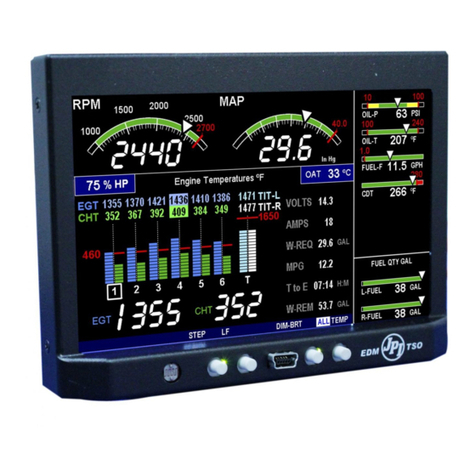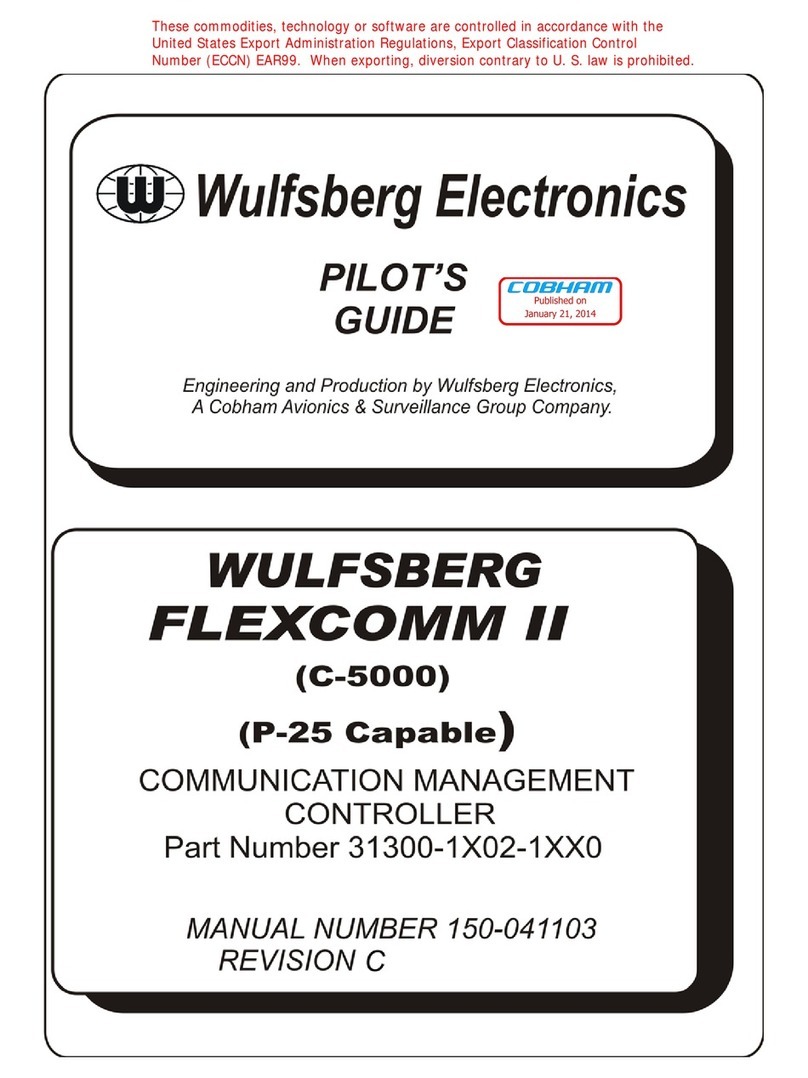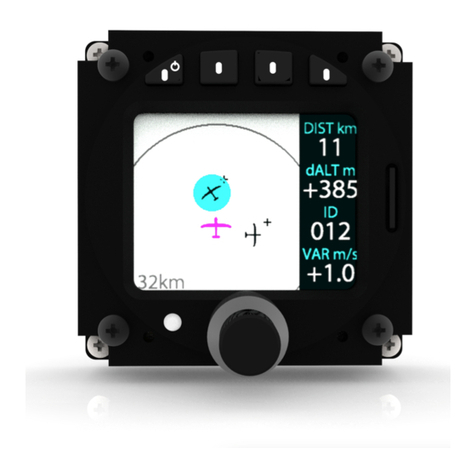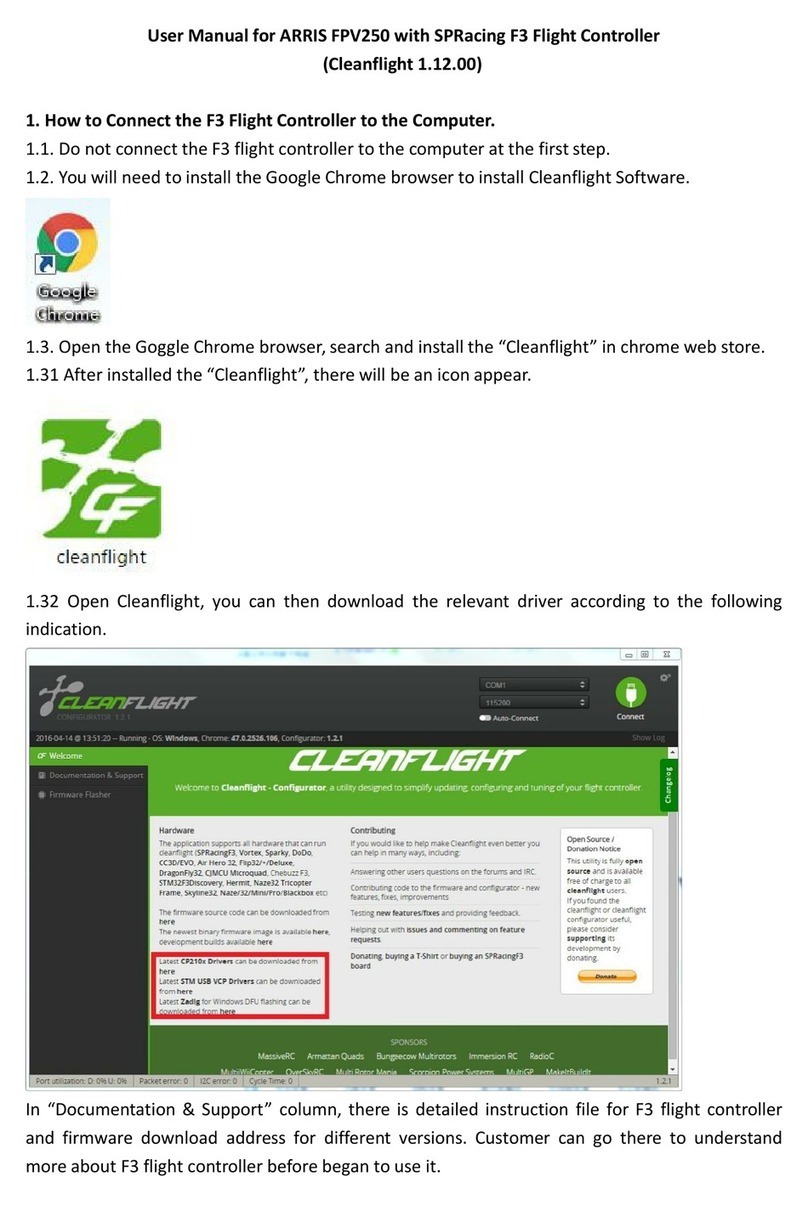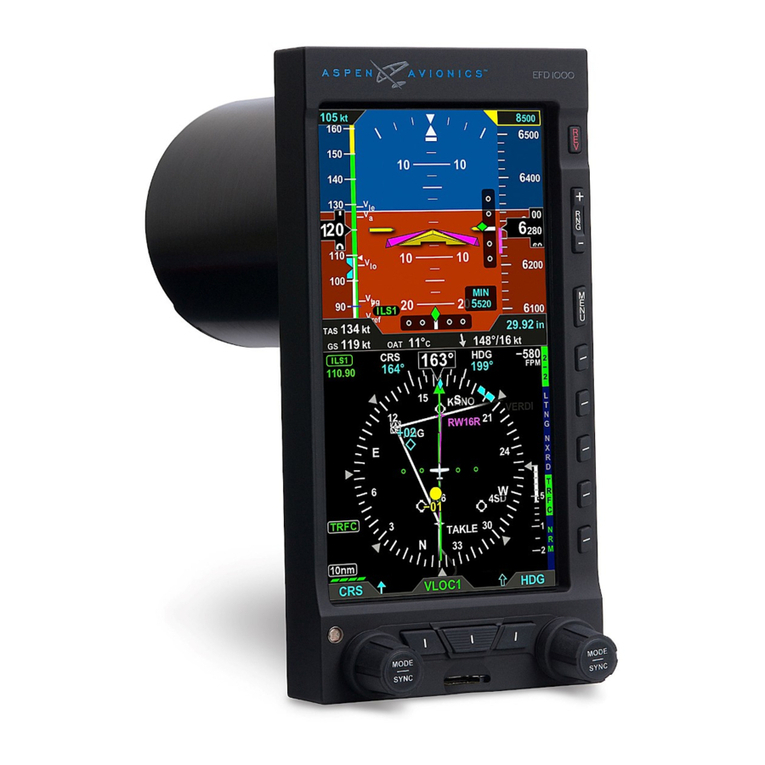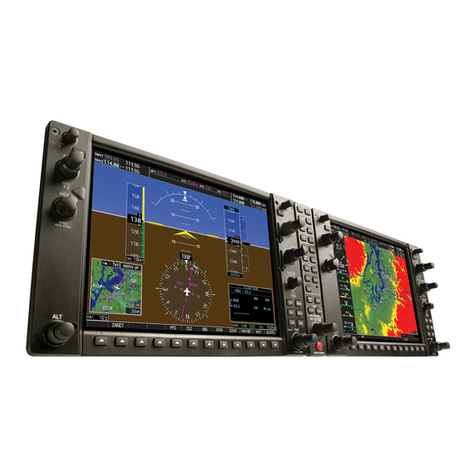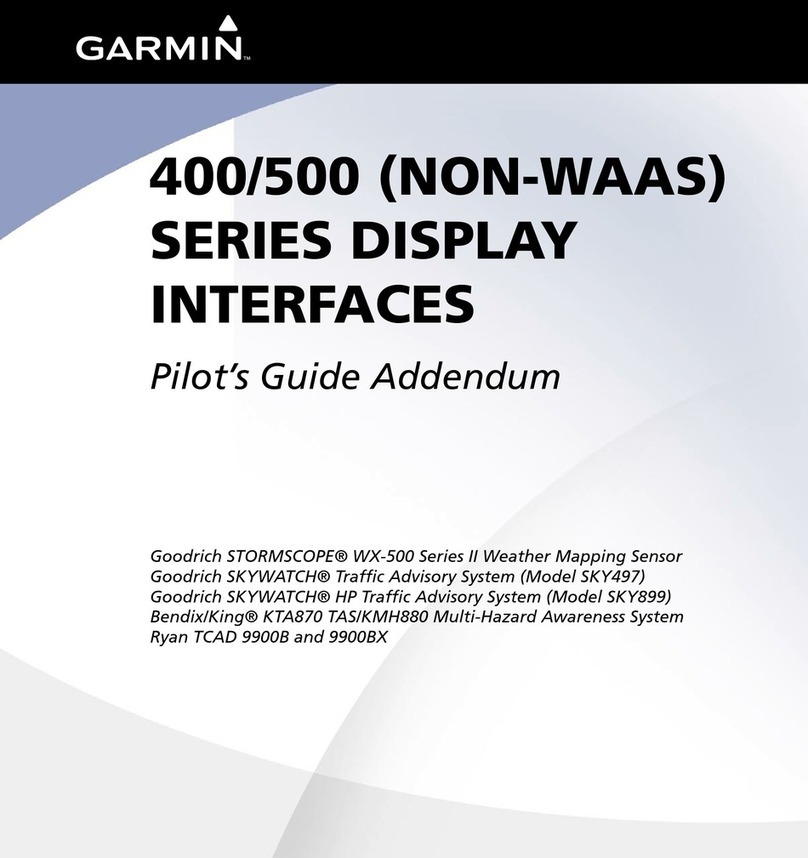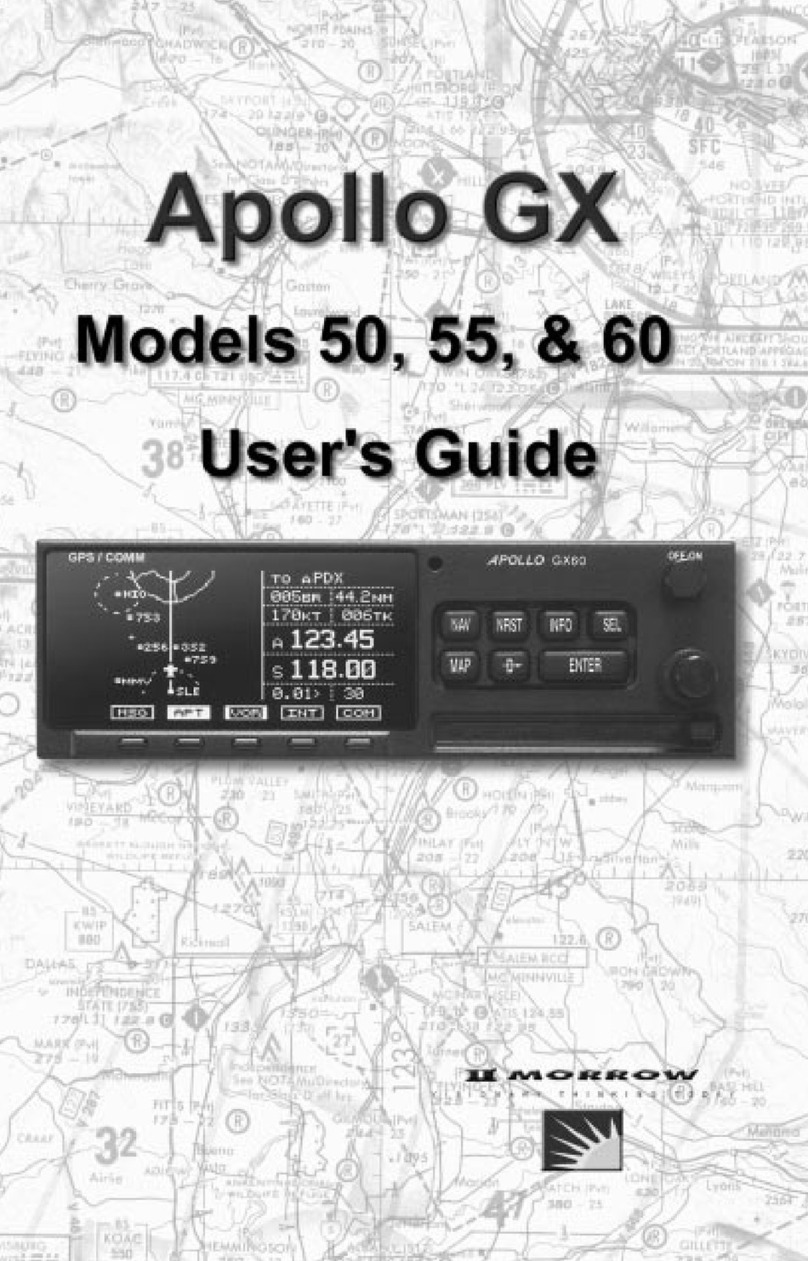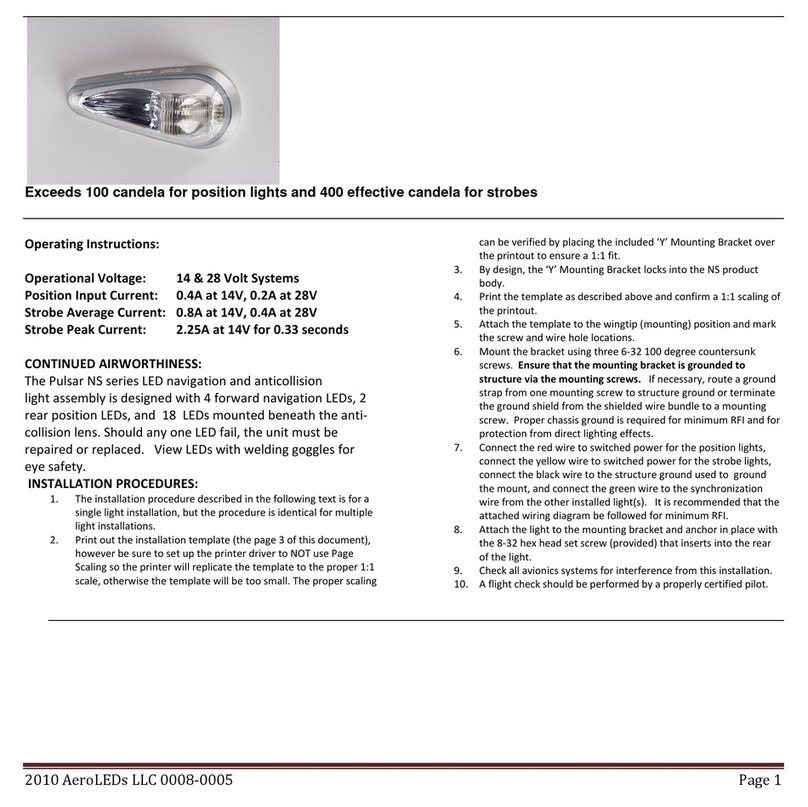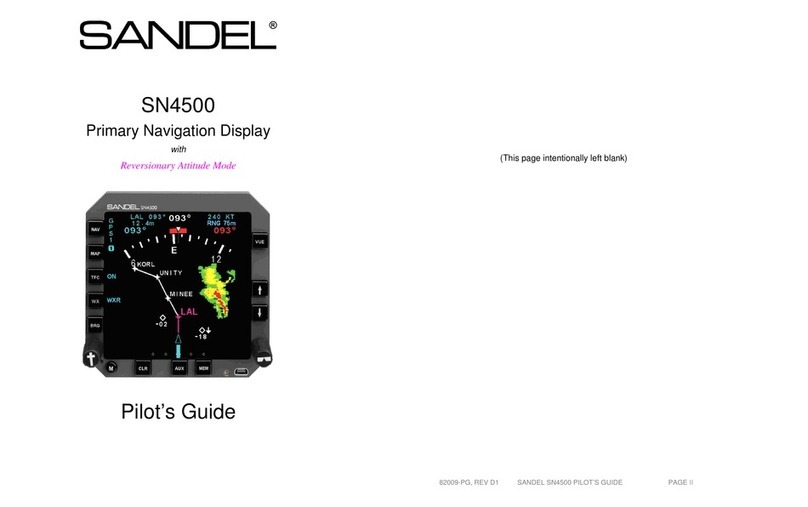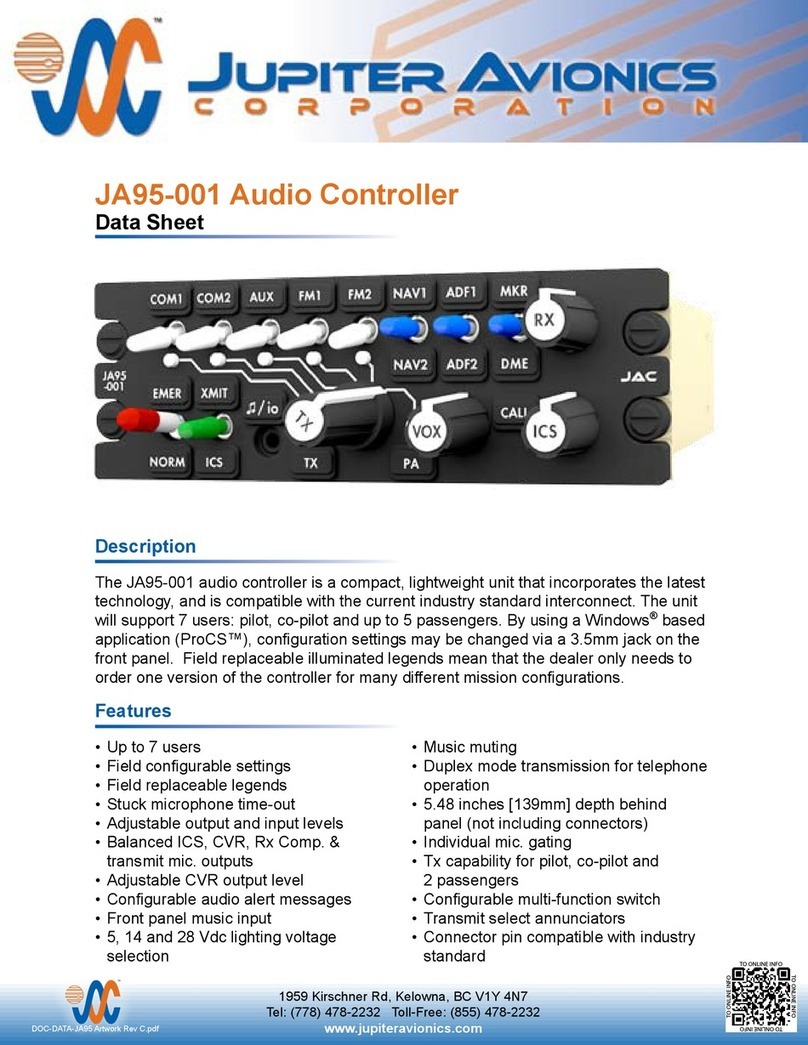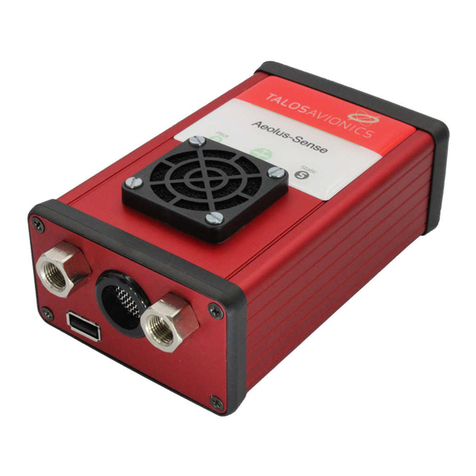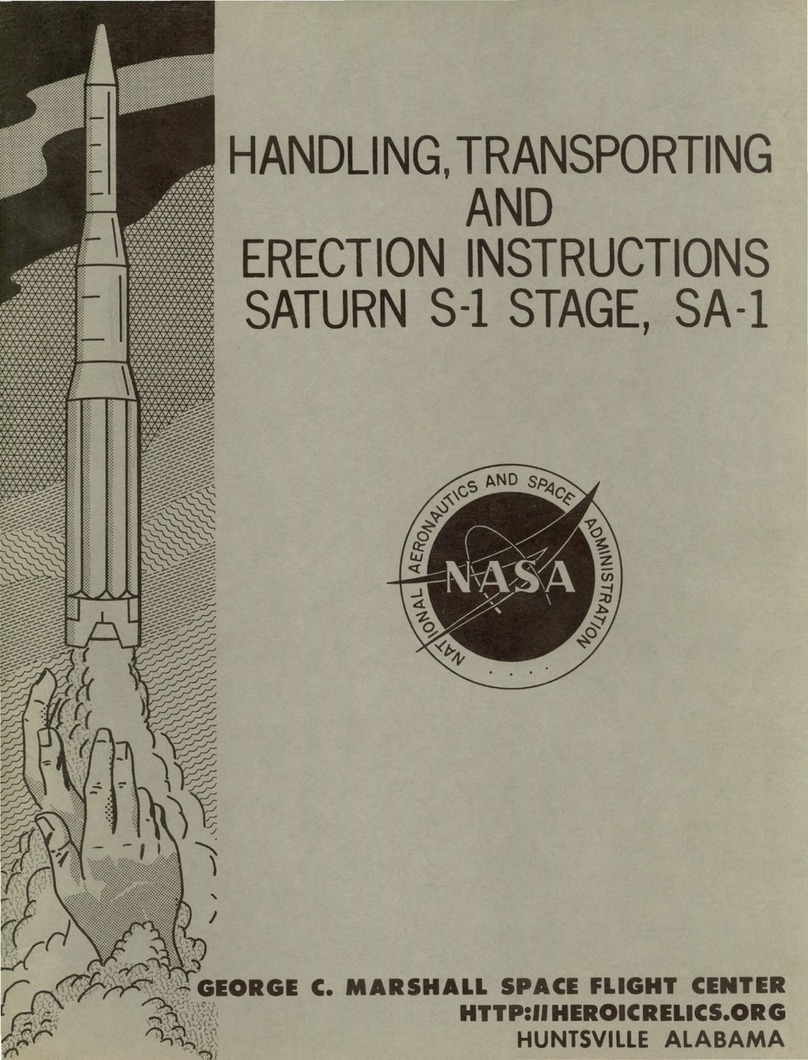trig TMA44 User manual

TMA44 Audio Panel
Installation Manual
01849-00-AB
7 November 2017
Trig Avionics Limited
Heriot Watt Research Park
Riccarton, Edinburgh
EH14 4AP
Scotland, UK
Copyright Trig Avionics Limited, 2017

This page intentionally left blank

TMA44 Audio Panel Installation Manual 7 November 2017
01849-00 Issue AB
______________________
Trig Avionics Limited i
CONTENTS
1.PREFACE...............................................................................................1
1.1PURPOSE ...........................................................................................1
1.2SCOPE ...............................................................................................1
1.3CHANGES FROM PREVIOUS ISSUE......................................................1
1.4DOCUMENT CROSS-REFERENCES......................................................1
2.INTRODUCTION .................................................................................2
2.1EQUIPMENT DESCRIPTION.................................................................2
2.2TSO HOLDER....................................................................................2
3.TECHNICAL SPECIFICATIONS ......................................................3
3.1PHYSICAL SPECIFICATIONS ...............................................................5
3.2APPROVAL BASIS ..............................................................................5
3.3LICENSE REQUIREMENTS ..................................................................5
4.UNIT AND ACCESSORIES SUPPLIED............................................6
4.1EQUIPMENT SUPPLIED.......................................................................6
4.2INSTALLATION KIT ...........................................................................6
4.3REQUIRED ITEMS ..............................................................................7
5.INSTALLATION...................................................................................8
5.1UNPACKING AND PRELIMINARY INSPECTION ....................................8
5.2EQUIPMENT INSTALLATION PROCEDURES.........................................8
5.2.1Cooling Requirements..............................................................8
5.2.2Mounting Requirements...........................................................9

TMA44 Audio Panel Installation Manual 7 November 2017
01849-00 Issue AB
______________________
ii Trig Avionics Limited
5.2.3Mounting Rack Installation......................................................9
5.2.4Audio Panel Tray and Connector Assembly ............................9
5.3CABLE HARNESS WIRING ...............................................................10
5.3.1Noise ......................................................................................10
5.3.2Entertainment Input (J1 pin 9 & 25)......................................11
5.3.3TMA44 Pin assignments ........................................................13
5.3.4External Push-to-Talk (J1 pin 32 pilot, J1 pin 31 co-pilot)...14
5.3.5Transmit Interlock..................................................................14
5.3.6Power (J1 pin 43)...................................................................14
5.3.7"Swap" Mode (J1 pin 11).......................................................15
5.3.8Backlighting (J1 pin 41).........................................................15
5.3.9Backlight Voltage Adjustment................................................15
5.3.10Middle Marker Sense (J1 pin 27 & 28)..................................17
5.3.11Unswitched Inputs (J1 pin 7, 22 & 24)..................................17
5.3.12Intercom.................................................................................17
5.4ADJUSTMENTS ................................................................................18
5.5MARKER ANTENNA INSTALLATION ................................................19
5.6COMMUNICATIONS ANTENNA INSTALLATION NOTES .....................19
5.7UNIT INSTALLATION .......................................................................19
6.POST INSTALLATION CHECKOUT.............................................20
6.1REQUIRED TEST EQUIPMENT ..........................................................20
6.2POWER TEST ...................................................................................20
6.3MARKER CHECKOUT.......................................................................21
7.FINAL INSPECTION.........................................................................22

TMA44 Audio Panel Installation Manual 7 November 2017
01849-00 Issue AB
______________________
Trig Avionics Limited iii
8.NORMAL OPERATION....................................................................23
8.1FRONT PANEL .................................................................................23
8.2POWER ON AND FAIL-SAFE OPERATION .........................................23
8.3TRANSMITTER SELECTION ..............................................................23
8.4RECEIVER SELECTION .....................................................................24
8.5NAVIGATION AUDIO SELECTION.....................................................24
8.6COCKPIT SPEAKER ..........................................................................24
8.7SWAP MODE ...................................................................................24
8.8SPLIT MODE....................................................................................25
8.9INTERCOM VOLUME........................................................................25
8.10INTERCOM SQUELCH.......................................................................25
8.11INTERCOM MODES ..........................................................................26
8.12INTERCOM MODE TABLE ................................................................27
8.13MUSIC INPUTS ................................................................................27
8.14MUSIC MUTING ..............................................................................27
8.15MARKER BEACON RECEIVER ..........................................................28
9.CONTINUED AIRWORTHINESS ...................................................29
9.1CLEANING THE FRONT PANEL.........................................................29
10.LIMITED WARRANTY.................................................................30
11.ENVIRONMENTAL QUALIFICATION FORM........................31
APPENDIX AEXTERNAL PTT HOOK UP.....................................33
PUSH TO TALK MODIFICATIONS .................................................................33
Procedures for David Clark PTT...........................................................34

TMA44 Audio Panel Installation Manual 7 November 2017
01849-00 Issue AB
______________________
iv Trig Avionics Limited
Procedures for Telex PT-200.................................................................34
Procedures for Telex PT-300.................................................................34
APPENDIX BINSTALLATION DRAWINGS..................................35
APPENDIX CWIRING/INTERCONNECT......................................37

TMA44 Audio Panel Installation Manual 7 November 2017
01849-00 Issue AB
______________________
Trig Avionics Limited 1
1. Preface
1.1 Purpose
This manual describes the physical and electrical characteristics and the
installation requirements for a TMA44 Audio Panel.
1.2 Scope
This manual applies to the installation of the TMA44 Audio Panel.
1.3 Changes from Previous Issue
No text changes – reformatted for A5.
1.4 Document Cross-References
01848-00 TMA44 Audio Panel Operating Manual
TSO C35d Airborne Radio Marker Receiving Equipment FAA
ETSO 2C35d Radio Marker Receiving Equipment EASA
TSO C50c Audio Selector Panels and Amplifiers FAA
ETSO C50c Audio Selector Panels and Amplifiers EASA

TMA44 Audio Panel Installation Manual 7 November 2017
01849-00 Issue AB
______________________
Page 2 Trig Avionics Limited
2. Introduction
2.1 Equipment Description
The TMA44 is a state of the art audio isolation amplifier and audio selector
that contains a voice activated (VOX) intercom system. It can switch up two
transceivers (Com 1, Com 2) and six receivers (Nav 1, Nav 2, ADF, DME,
MKR and AUX). In addition, there are two unswitched inputs, for priority
audio sources such as TAWS or altimeter warning. Push buttons select the
receiver audio sources provided to the headphones. A speaker button allows
the user to listen to the receiver(s) selected on the cabin speaker. Except for
the unswitched inputs, all speaker audio is muted during transmit. Push
buttons select one of the transceivers for the pilot and co-pilot position in
transmit. In "Split Mode" the TMA44 allows the pilot and co-pilot to operate
different transmitters independently.
A fail-safe mode connects the pilot headphone and microphone to Com 1 and
unswitched input 1 if power is removed for any reason, or if the audio panel is
turned off by pushing the volume control.
A four-station voice activated (VOX) intercom is included in the TMA44.
Pilot isolate and crew modes, two mono music inputs with "Soft Mute" and
transmit indications. Intercom control is through front panel mounted knobs.
Dual concentric knobs control intercom volume and intercom squelch.
A 3-light Marker Beacon receiver is integral to the TMA44. This provides the
necessary Marker Beacon light and audio indications necessary for an
Instrument Landing System (ILS) approach.
2.2 TSO Holder
The TSO holder and manufacturer of the TMA44 is PS Engineering, Lenoir
City, TN, USA.
US patents no. 5,903,227 and 6,160,496 apply.
SoftMute is a trademark of PS Engineering.

TMA44 Audio Panel Installation Manual 7 November 2017
01849-00 Issue AB
______________________
Trig Avionics Limited 3
3. Technical Specifications
Specification Characteristics
Compliance Marker Beacon: TSO C35d, Class A, ETSO
2C35d
Audio Selector/Intercom: TSO C50d, Class A,
ETSO C50c
Applicable documents RTCA DO-160B, RTCA DO-170 and RTCA
DO-143
Power Requirements Voltage: 14 or 28 VDC*
Maximum current 1 amp (externally protected
by a 2 amp circuit breaker). Typical operating
current 350 mA (speaker off), 600 mA
(speaker on).
*28 VDC requires 15W dropping resistor
(included)
Altitude Up to 50,000 feet in a non-pressurised area of
the cockpit
Operating Temperature -20°C to +55°C
Storage Temperature -40°C to +85°C
Input impedance 510
Input Isolation -70 dB (min.)
Speaker Muting -60 dB (min.)
Speaker Output (into 4 ) 3 watts (min.) with no clipping
Switched Receiver Inputs 8 (Com 1, Com 2, Nav 1, Nav 2, ADF, DME,
MKR, AUX)
Unswitched Inputs 2
Transmitter Selections 3; Com 1, Com 2, Com 1/2

TMA44 Audio Panel Installation Manual 7 November 2017
01849-00 Issue AB
______________________
Page 4 Trig Avionics Limited
Speaker Impedance 4
Headphone Impedance 150 - 1000
Headphone Output 45 mW each headset with no clipping
Microphone Impedance 150 - 600
Intercom Positions 4 places (monaural)
Music Inputs 2
Music Muting
Distortion
>50 dB "Soft Mute" when Radio or intercom
active
<1% THD@ 45 mW into 150
Mic Freq. Response, ±3 dB 350 Hz - 6000 Hz
Music Freq. Response, ±3 dB 200 Hz - 15 kHz
Marker Beacon Receiver
Frequency
75 MHz Crystal Controlled
Marker Beacon Receiver
Sensitivity
Low: 450 µV (Hard) Factory adjusted to
1400µV (Soft)
High: 160 µV (Hard) Factory adjusted to
150µV (Soft)
Marker Beacon Receiver
Selectivity
-6 dB at 110 kHz, -40 dB at 120 kHz
External Lamp Output 7.0 (+/- 4) VDC positive when active, max.
current 125 mA
MM Sense Active high (4.7 VDC +/- 0.5V) during
Middle Marker acquisition, for autopilot use

TMA44 Audio Panel Installation Manual 7 November 2017
01849-00 Issue AB
______________________
Trig Avionics Limited 5
3.1 Physical Specifications
Specification Characteristics
Height 33 mm (1.30”)
Width 159 mm (6.25”)
Depth 173 mm (6.8”)
Weight 0.68 kg (1.5lbs)
3.2 Approval basis
The TMA44 is FAA authorised under TSO C50c (Audio Amplifiers) and TSO
C35d (Marker Beacon Receivers).
The TMA44 is EASA authorised under ETSO C50c and ETSO 2C35d, ref
EASA.IM.21O.10028565
All systems comply with RTCA DO-143, DO-160B, DO-170, and EUROCAE
1/WG7/70.
TSO Holder and Manufacturer PS Engineering, Lenoir City TN USA
Operation is subject to the following conditions:
1. This device may not cause harmful interference.
2. This device must accept any interference received, including
interference that may cause undesired operation
3.3 License Requirements
None

TMA44 Audio Panel Installation Manual 7 November 2017
01849-00 Issue AB
______________________
Page 6 Trig Avionics Limited
4. Unit and Accessories supplied
4.1 Equipment Supplied
Unit Description Qty Part Number
TMA44 Audio Panel 1 01861-00-01
TMA44 Installation kit 1 250-604-0000
TMA44 Mounting Tray 1 430-890-0040
TMA44 Pilots Operating Handbook 1 01848-00
TMA44 Installation Manual 1 01849-00
4.2 Installation Kit
The TMA44 installation kit includes the following items:
Unit Description Qty Part Number
Cable Clamp 1 625-001-0002
6-32 Clip Nut 6 475-630-0002
6-32 x ½” Phillips flat head screw 6 475-632-0012
4-40 x 7/16” Phillips pan head screw, nylon patch 4 475-440-0007
4-40 x 3/8” Phillips truss head screw, nylon patch 2 475-440-1038
4-40 x ¼” Phillips pan head screw, lock washer 2 475-440-0001
Solder lug terminal 2 475-009-0001
TMA44 backplate 1 430-890-0050
DB44 metal backshell 1 625-025-2465
Cast DB44 retaining block 1 431-891-0100
44-pin connector kit 1 120-891-2045

TMA44 Audio Panel Installation Manual 7 November 2017
01849-00 Issue AB
______________________
Trig Avionics Limited 7
Unit Description Qty Part Number
15Ω, 15W dropping resistor 1 701-015-1501
4.3 Required Items
Additional items you will require, but which are not in the TMA44 package,
include:
Speaker, 4
Headphones, mono, up to 4 as required
Microphones, up to 4 as required
Marker Antenna (75 MHz, VSWR <1:1.5, as appropriate)
Interconnect Wiring
Headphone Jacks (Up to 4 as required)
Microphone Jacks (Up to 4 as required)
Circuit Breaker, 2 amp

TMA44 Audio Panel Installation Manual 7 November 2017
01849-00 Issue AB
______________________
Page 8 Trig Avionics Limited
5. Installation
This section provides detailed installation and interconnect instructions for the
TMA44 Audio Panel.
Please read this manual carefully before beginning any installation to prevent
damage and post installation problems. Installation of this equipment requires
special tools and knowledge.
5.1 Unpacking and Preliminary Inspection
Use care when unpacking the equipment. Inspect the units and parts supplied
for visible signs of shipping damage. Examine the unit for loose or broken
buttons, bent knobs, etc. Verify the correct quantity of components supplied
with the list in Section 4. If any claim is to be made, save the shipping material
and contact the freight carrier. Do NOT return units damaged in shipping to
Trig. If the unit or accessories shows any sign of external shipping damage,
contact Trig to arrange for a replacement. Under no circumstances attempt to
install a damaged unit in an aircraft. Equipment returned to Trig for any other
reason should be shipped in the original Trig packaging, or other UPS
approved packaging.
5.2 Equipment Installation Procedures
5.2.1 Cooling Requirements
Forced-air cooling of the TMA44 is not required. However, the unit should be
kept away from heat producing sources such as defrost or heater ducts,
dropping resistors or heat producing avionics without adequate cooling air
provided.
If the TMA44 is installed in a 28 VDC aircraft system, a 15 , 15 watt
dropping resistor (p/n 701-015-1501) should be installed. Failure to do so will
generate unnecessary heat inside the unit and may void Trig's warranty.

TMA44 Audio Panel Installation Manual 7 November 2017
01849-00 Issue AB
______________________
Trig Avionics Limited 9
5.2.2 Mounting Requirements
The TMA44 must be rigidly mounted to the instrument panel of the aircraft
structure and within view and reach of the pilot position(s). Installation must
comply with FAA Advisory Circular AC 43.13-2B. The unit may be mounted
in any area where adequate clearance for the unit and associated wiring bundle
exist.
5.2.3 Mounting Rack Installation
Remove the unit from the mounting tray unscrewing the 3/32-inch hex-head
screw that is in the centre of the unit. The hex-head screw is the lower
opening. Carefully slide the unit free of the tray. Set the unit aside in a safe
location until needed. Install the tray using six flat head Phillips 6-32 x ½-
inch screws, P/N 475-632-0012 and 6-32 clip nut, P/N 475-630-0002. The
audio selector panel must be supported at front and rear of the mounting tray.
5.2.4 Audio Panel Tray and Connector Assembly
The rack connectors mate with one 44-pin connector in the TMA44. The
connector is a sub-miniature crimp-type, and require the use a hand crimp tool,
from table below (or equivalent). The connector is mounted to the tray back
plate with 4-40 screws (475-440-1038), from the inside of the tray and the
mounting block, 431-891-0100. Ensure that proper strain relief and chafing
precautions are made during wiring and installation, using the cable clamp
(625-001-0002).
Two grounding lugs are provided, which may be attached to the rear mounting
plate with 2 4-40 x ¼” screws with captive lock washers. These provide a
convenient location to connect the shield ground terminations.
Manufacturer Crimping Tool Positioner Extraction Tool
AMP 601966-1 601966-6 91067-1
Daniels AFM8 K42 M24308-1
ITT-Cannon 995-0001-584 995-0001-739 91067-1
Table 5-1 Connector Pin crimping tools

TMA44 Audio Panel Installation Manual 7 November 2017
01849-00 Issue AB
______________________
Page 10 Trig Avionics Limited
5.3 Cable Harness Wiring
Refer to Appendix C for assembling the wiring harness as required for the
installation. All wires must be MIL-SPEC in accordance with current
regulations. Two- and three-conductor with shield wire must be used where
indicated, and be MIL-C-27500 or equivalent specification. Proper stripping,
shielding and soldering technique must be used at all times. It is imperative
that correct wire be used.
Refer to FAA Advisory Circular 43.13-2B for more information. Failure to use
correct techniques may result in improper operation, electrical noise or unit
failure. Damage caused by improper installation will void the Trig warranty.
5.3.1 Noise
Due to the variety and the high power of radio equipment often found in
today's general aviation aircraft, there is a potential for both radiated and
conducted noise interference.
The TMA44 power supply is specifically designed to reduce conducted
electrical noise on the aircraft power bus by at least 50dB. Although this is a
large amount of attenuation, it may not eliminate all noise, particularly if the
amplitude of noise is very high. There must be at least 13.8 VDC present at the
bottom connector, pin 43, of the TMA44 for the power supply to work in its
designed regulation. Otherwise, it cannot adequately attenuate power line
noise. Shielding can reduce or prevent radiated noise such as beacons, electric
gyros, or switching power supplies, but installation combinations can occur
where interference is possible. The TMA44 is designed in a RFI hardened
chassis and has internal Electromagnetic Interference (EMI) filters on all
inputs and outputs.
Ground loop noise occurs when there are two or more ground paths for the
same signal, such as the airframe and a ground return wire. Large cyclic loads
such as strobes or inverters can inject noise signals onto the airframe that are
detected by the audio system. Follow the wiring diagram very carefully to help
ensure a minimum of ground loop potential. Use only MIL-SPEC shielded
wires (MIL-C-275000, or better). Under no circumstances combine a
microphone and headphone wiring into the same shielded bundle. Always use

TMA44 Audio Panel Installation Manual 7 November 2017
01849-00 Issue AB
______________________
Trig Avionics Limited 11
a 2 or 3 conductor shielded wire as shown on the installation wiring diagram.
The shields can be daisy-chained together, and then connected to the ground
lugs mounted on the back plate shown in Appendix B.
Radiated signals can be a factor when low-level microphone signals are
"bundled" with current carrying power wires. Keep these cables physically
separated. It is very important that you use insulated washers to isolate the
ground return path from the airframe to all headphone and microphone jacks.
Note: Adding a high-performance audio control system, particularly
in conjunction with active noise cancelling headsets, cannot improve
on older avionics that were designed for cabin-speaker use. Trig
makes no claim that the audio panel will provide a noise-free audio
quality under all installation conditions, particularly with older
avionics.
5.3.2 Entertainment Input (J1 pin 9 & 25)
Two entertainment devices (MP3 player, Portable Satellite Radio, CD player,
etc.) can be connected to the unit. Install two 1/8-inch jacks in a convenient
location so that the pilot can plug in the entertainment devices into the system.
NOTE: Use the low level output of any entertainment device to
connect to the audio panel. Maximum signal level is 2 VAC p-p. DO
NOT use a speaker-level output, this will cause internal damage in
the audio panel.
For a stereo input, we do not recommend tying the left and right channels (tip
and ring) directly together unless approved by the music source manufacturer.
A small series resistor in each channel is usually required. The audio signal at
the entertainment input must be a minimum of 500 mV P-P for optimum music
performance.
5.3.2.1 Soft Mute
The TMA44-system incorporates a "Soft Mute" system. This will mute the
entertainment devices during ICS or radio traffic. While in the ALL or ISO
modes, entertainment 1 is heard by everyone (except by the pilot in ISO

TMA44 Audio Panel Installation Manual 7 November 2017
01849-00 Issue AB
______________________
Page 12 Trig Avionics Limited
mode). While in the CREW mode, pilot and co-pilot will hear entertainment 1
while the passengers will hear entertainment 2.
The “Mute” button can be used to inhibit the soft mute function, keeping
music at the same level. In CREW mode, passengers will hear Music 2, and
this will be controlled by the “Mute” button located on the front panel.
Entertainment inputs 1 and 2 can be paralleled so a single entertainment source
can serve both the passengers and the crew in "crew" mode. It is suggested
however, that a switch (DPDT) is installed between the single entertainment
device and entertainment input 1. This will allow the pilot and co-pilot to
decide if they hear entertainment while in the Crew mode.
Local oscillators and internal signals from some entertainment equipment can
cause undesired interference with other aircraft systems. Before take-off,
operate the entertainment devices to determine if there is any adverse effect
within the aircraft systems. If any unusual operation is noted in flight,
immediately switch off the entertainment devices.

TMA44 Audio Panel Installation Manual 7 November 2017
01849-00 Issue AB
______________________
Trig Avionics Limited 13
5.3.3 TMA44 Pin assignments
Pin Function Pin Function
1 Co-pilot Mic Audio 2 Pilot Mic Audio Hi
3 Passenger Mic Hi 4 Com 1 Mic Audio
5 Com 1 Mic Key 6 Com 1 Audio In
7 Unswitched 1 Hi 8 Nav 1 Input
9 Music 1 Hi 10 Pilot Headphone
11 Swap 12 Blue Lamp Out
13 Amber Lamp Out 14 Speaker Ground
15 Marker Antenna 16 Co-pilot Mic Lo
17 Pilot Mic Low 18 Passenger 1 Mic Lo
19 Passenger Mic Lo 20 Com 1 Lo
21 Com 2 Mic Key 22 Unswitched 2 Hi
23 Nav 2 Audio Hi 24 Audio Low
25 Music 2 Hi 26 Co-pilot Phones Hi
27 MM Sense 28 Marker Low
29 Airframe Ground 30 Marker Antenna Ground
31 Co-pilot Mic PTT 32 Pilot Mic PTT
33 Passenger Mic Hi 34 Com 2 Mic Audio
35 Com 2 Audio Lo 36 Com 2 Audio
37 ADF Audio Input 38 Aux Audio Hi
39 DME Audio Hi 40 Passenger Phones Hi
41 Dimmer Input 42 White Lamp Out
43 Aircraft Power 44 Speaker Hi

TMA44 Audio Panel Installation Manual 7 November 2017
01849-00 Issue AB
______________________
Page 14 Trig Avionics Limited
5.3.4 External Push-to-Talk (J1 pin 32 pilot, J1 pin 31 co-
pilot)
An important part of the installation is the PTT (Push-To-Talk) switches that
allow the use of your aircraft communications radio for transmissions. There
are three typical configurations that can be used. Select the case that best fits
the installation. Only the person who presses their PTT switch will be heard
over the radio. If the pilot and co-pilot both use the PTT, the co-pilot position
has access to the radio. The pilot position will have PTT control regardless of
the co-pilot when the TMA44 is in the FAIL-SAFE mode.
CASE 1: PTT is built into both pilot and co-pilot yokes.
CASE 2: PTT is in pilot yoke only. This configuration requires a modified
external PTT switch plugged into the co-pilot's microphone jack. (See
Appendix A). When the co-pilot's PTT is pressed, the intercom switches the
mic audio from pilot to co-pilot mic.
CASE 3: No built in PTT. This requires two built in PTTs to be installed, or
modified external PTT switches to be used. Modify external PTT as required
(See Appendix A).
5.3.5 Transmit Interlock
Some communications transceivers use a transmit interlock system which
changes the behaviour of one radio when the other one is transmitting. In
order to use the Split Mode feature, this function will need to be correctly
configured.
If you are using Trig radios, the transmit interlock pin on each radio should be
connected to the PTT of the other radio. For other brands, consult the
manufacturer installation manual.
5.3.6 Power (J1 pin 43)
The TMA44-Series are compatible with both 14 and 28 volt DC systems. A
two (2) amp circuit breaker is required. Power and ground wires must be a
twisted 22 AWG pair.
Other manuals for TMA44
1
Table of contents
Other trig Avionic Display manuals


